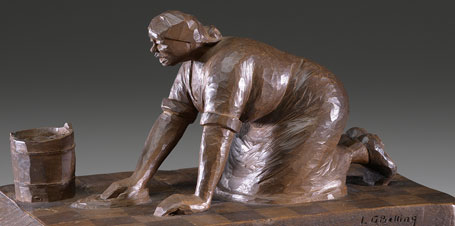
Cousin-on-Friday, 1935
Maple
6 ¾ x 5 ¾ x 9 ¼ inches
Gift of the Honorable and Mrs. Alexander W. Weddell, 44.2.1
I’ve always felt like I needed to use my hands creatively. I started cutting human figures out of paper, but I felt like I needed to more substance and resistance, so I started cutting them out of cardboard. To get more depth, I stuck sheets of pasteboard together and cut those. Eventually, I realized that I could get the perfect balance of malleability and resistance using soft wood. Growing up in Surry County, Virginia, I always loved trees, and my friends used to always talk about the funny little things I carved.
After I season the wood, I draw a rough sketch of what I plan on doing, then use my knife to make an approximate shape of the figure. When I’ve cut my figure down to about an eighth of an inch of what it will look like finished, I start in on the detail. I work something the way a cartoonist does. I try to pick out the most important, the most obvious details of a man’s face, for instance, and concentrate on them.
I brought my love of carving with me when I moved to Richmond and attended Virginia Union University, taking classes in Manual Training that included mechanical and freehand drawing, designing, and the use of tools in wood and iron work and blacksmithing. However, I carve my figures with an ordinary pocketknife. I don’t own a set of woodcarving tools.
After writer Carl Van Vechtenhelped bring my work to the attention of the Harmon Foundation in New York, my carvings were shown in several exhibitions across the country. As the first Negro artist to have a solo exhibit in Virginia, I had some success in selling sculptures in Richmond. Still, I needed to keep my job as a porter in a local stationary shop to make a living.
